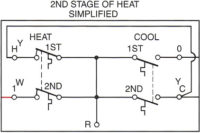Bob has gone on a service call where the customer is complaining that her house is not getting up to temperature. The house was heated with a heat pump with three stages of auxiliary strip heat. When Bob arrived, the owner took him to the thermostat and showed him that it is set at 72°F, but the thermometer shows it is 69°. Bob uses his thermometer to check the return air temperature and sure enough it is cool in the house. The outside temperature is 10° so the system is calling for all of the capacity that it can get.
Bob started thinking and decided to check heat pump first. It was not covered with frost, and the discharge line was hot, so the heat pump seemed to be heating like it should. It would be a bad sign if the heat pump were to be frosted in excess. Usually in very cold, dry weather there is not a problem with frost. Frost is usually at its worst when there is a lot of moisture in the air. If the coil were to be partially frosted, he might suspect low charge, but this system looked normal for the conditions without installing gauges on the system. He then decided to check the electric heat system that is used as additional heat to supplement the heat pump.
He went to the air handler with his voltmeter and ammeter. He removed the panel to the strip heat and one of the units was not pulling current, so it was not heating. Now, he was sure that the sequencer that energizes that heater must be defective, so he turned off the power and changed it out. He then turned on the power and started the system up. He waited for enough time to pass that everything should be running and checked the amperage again. There was no current flowing so the heater was not working.

Figure 1. This illustration shows a fuse link that has opened up due to overheating. (Figures are from Practical Heating Technology, by William Johnson, published by Delmar Cengage Learning.) (©Delmar Cengage Learning.) (Click on the image for an enlarged view.)
Bob then thought the heating element must be defective so he shut the power off again and pulled the element back where he could see and discovered that the fusible link was open (Figure 1). It was the type that can be seen. Now he has found the problem. He changed the fusible link, reinstalled the old sequencer, put the system back together, and started it up.
It was now pulling current on all three heating elements. Bob was ready to go when Btu Buddy showed up and asked, “What do you think caused that link to open?”
Bob said, “I guess it was just a random failure.”

Figure 2. This is a thermal switch and may open at about 170°F. It is automatic reset. (©Delmar Cengage Learning.) (Click on the image for an enlarged view.)
Bob said, “For some reason, there may not be enough airflow. I am going to take a look around.”
Btu Buddy said, “There are several reasons for reduced airflow. Look this illustration over (Figure 3).”
Bob then went to the owner and reported that he needed to look around in each room to see if there were any air restrictions. In two rooms, he found that the owner had shut the supply registers off to save money. Bob opened them. He then explained to the owner that restricted airflow could cause this problem. The house had a return air inlet in most of the rooms. Some of them were in the floor and he found two that had small rugs over them. The owner said that there was a cold draft when sitting next to these grilles so she covered them up. Bob explained why that could not be done. He helped her move the furniture around a little bit to avoid people being uncomfortable.

Figure 3. This is an illustration of the possible places that can cause reduced airflow in a duct system. (©Delmar Cengage Learning.) (Click on the image for an enlarged view.)
Btu Buddy said, “You fixed several things that would cause a rise in air temperature. I think that the reduced airflow across the heaters caused that fuse link to fail. I believe you have fixed the problem. I believe that I would change the thermal element that did not protect the fuse link. They are not expensive and I have a feeling that it had opened and closed too many times and is probably welded shut. Otherwise, the fuse link would not have failed.”
Bob changed the thermal element.
Bob then explained to the owner what he had done. He went on to explain that reducing the airflow to the rooms, the rugs over the return air grilles, and the dirty filter and coil all caused the system temperature and pressure to rise. This caused the failure of the part. In addition to the part failure, these things hurt the efficiency of the heat pump and would cause excess power usage to heat the house. He then suggested that his company furnish a service contract for a regular checkup that would catch these things and prevent problems like the ones that just occurred. She agreed to meet with the salesman about the service contract.
Btu Buddy said, “You did a good job, except for changing the sequencer. You must always try to think of why a component failed. Manufacturers work really hard to make these systems reliable and trouble free.”
Bob said, “It is easy to get in a hurry and not think. There is always the pressure of the next call you need to be on.”
Btu Buddy responded, “That is true, but you must try to get it right the first time. A call back is free to the customer, but it costs your company money.”
Publication date:01/24/2011










